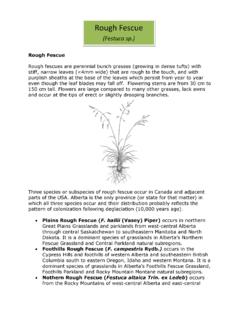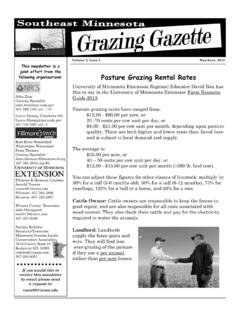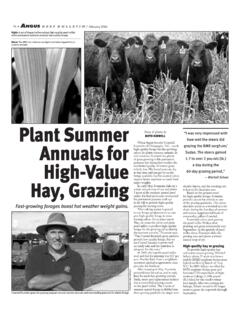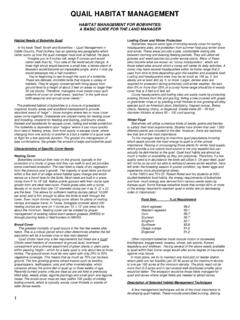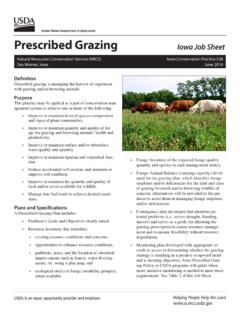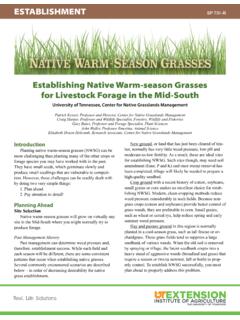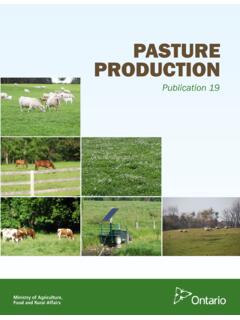Transcription of SOME PERCEPTIONS - Alberta Prairie Conservation Forum
1 - 1 - some PERCEPTIONST ough HideIn the proper location, the right native grass mixture produces a tough, permanent vegetative cover or hide over land once battered by wind and water. Native grasses provide palatable hay and sustainable pasture vegetation for livestock that remains productive throughout highly variable grazing seasons, generation after generation. Native grasses also provide exceptional habitat for a diversity of wildlife. Further, deep-rooted native grasses are known to be able to sequester significant amounts of atmospheric Than Seeds Revegetating with native grass species requires a detailed management plan including a clean seedbed, sowing seed of appropriate native species, and nurturing the sensitive new growth into a hardy grass cover.
2 Most InfluenceFactors such as topsoil depth, soil texture, available soil moisture, land slope and exposure, precipitation, soil fertility and salinity in-fluence native plant species composition and biomass production. Advice on generally suitable, standardized mixtures can be found in the Revegetating with Native Grasses in the Northern Great Plains manual ( ) or contact DUC, AAFC or your provincial agriculture department s grassland , Warm or Both? For the sake of plant diversity and better all-season grass growth for pasture applications, most recommended native grass mixtures combine cool season and warm season species.
3 Cool season grasses begin annual growth in early spring, grow rapidly through early summer and usually become dormant during the hottest, driest portion of summer. There may be a second flush of growth in late summer and early fall. Warm season grasses begin growth in late spring. Production continues throughout the summer, especially from July to mid-September. Large-scale patterns and trends exist across the Canadian Great Plains. In the northeastern Prairie , adequate soil resources and a compara-tively short growing season favours highly productive, cool season grasses over short, warm season species.
4 Conversely, lower levels of soil resources (water and/or nutrients) in the northwestern prairies favour short-statured cool season grasses with well developed root systems. Warm season grasses tend to do well as the number of grow-ing degree days increases. In the southeastern prairies, productive tall, warm season grasses are generally favoured, whereas short, warm season grasses are common in association with drought-tolerant, cool season grasses in the southwestern Cover That LastsThere is a strong move afoot by reclamation agencies and, increasingly, the agricultural community to revegetate significant land parcels within the Canadian Prairies to return some of the land to its original roots or, at least, its original grass revegetation is not a fad, it is a common-sense effort backed by sound science.
5 Native grasses, when properly reintroduced to a much-changed environment, can provide the best, longest lasting cover for erosion-prone land, degraded fields and once-broken areas that were better suited to production of perennial than annual native grasses is not a simple exercise. It requires a renewed round of agronomic research and field testing and a focus on quality seed development and production. Extension programs to help farmers and ranchers pioneer permanent native grass seeding and management are evolving. Strong research support is being provided in Canada by DUC and AAFC. Farmers, ranchers, utility companies and mining companies have developed a growing expertise to ensure native grass is incorporated into their land use goal of this publication part of a joint project funded by Ducks Unlimited Canada (DUC) and Agriculture and Agri-Food Canada s (AAFC) Greencover Canada Program is to assist farmers, ranchers and environmental agencies with native grass revegetation efforts.
6 These insights and guidelines are designed for readers who have a basic understanding about native grass revegetation. A more detailed, step-by-step overview is in the Revegetating with Native Grasses in the Northern Great Plains manual. ( )Cautionary NoteWithin this publication, references to specific herbicides and rates of application are based on preliminary research and field experience. Unless stated otherwise, they should NOT be construed as recommendations for herbicide use. For example, the effect of a particular herbicide on native grass seedlings can vary with the level of weed infestation and the stage of seedling development.
7 In addition, a herbicide may not have an impact on vegetative growth or biomass production, but may significantly reduce seed yields. For specific recommendations for local conditions, refer to provincial weed control publications, herbicide label information and experienced local Authors:L. K. Gabruch D. B. Wark C. G. Penner J. GilesThe authors wish to thank the DUC staff whose experience has contributed to this authors wish to thank funding partners who underwrote the preparation and publication of this and Agri-Food Canada s Greencover Canada ProgramDepartment of Fisheries and OceansDucks Unlimited CanadaProven SeedA healthy landscape has many microenvironments.
8 These variations can result from differing elevations and slopes, soil composition and fertility, soil moisture content and salinity, to name a few factors. In nature, such variations support slightly to widely different combina-tions of native plant species. Under a commercial crop regime, it is simply not practical to adjust what is planted to account for these frequent range site variations. The single commercial crop or uniform forage mixture simply varies in performance from site to site within a the objective is long-term or permanent revegetation, how-ever, both diversity of plants and persistent good cover are important.
9 It makes sense, then, to make the effort to fit the native vegetation mixture to each significant range site. For example, a native grass mixture for eroded knolls might be seeded on the highest elevation just above the mid Prairie zone slope (see Figure 1), while another, more appropriate mix is seeded below that in the wet meadow planting design must reflect environmental variability. This approach makes good ecological and economic Planting species that will not persist is not recommended because, as seedlings they compete with site-appropriate species for moisture and nutrients. This can result in under-representation of site-appropriate species as the stand matures, leaving open areas which are prone to weed invasion.
10 Establishing species in the environment to which they are best suited will yield more stable, diverse and more sustainable ground cover in the short and long 2 -TRaNSITION ZONESThe ChallengeGenerally, most native grass species are somewhat less competitive than traditional forage species at the seedling stage. During estab-lishment the importance of site preparation and weed control is more critical than when establishing a tame forage stand. The extra effort in site preparation and managing the seedling stand will pay off in a long-lived, low maintenance 1 Economic Planting expensive seed of native species in sites where they will not persist is not a wise investment, due to increased need for reseeding and reduced productivity.
